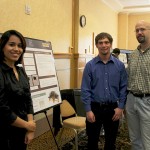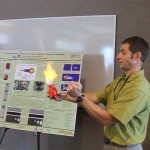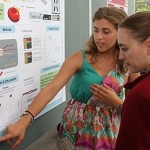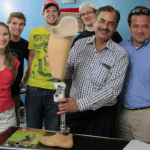Professor Gregory M Odegard, of the Department of Mechanical Engineering – Engineering Mechanics
Michigan Technological University will present the Graduate Seminar, Thursday, Sept. 5, 2013 4:00 – 5:00 p.m. Room 112, ME-EM Bldg.
Dr. Gregory M. Odegard will present an overview of presentation guidelines will be given. This will cover suggested presentation content, formatting, organization, and style. Examples will be given of poor presentation slides.is an Assistant Professor in the Department of Mechanical Engineering – Engineering Mechanics, and an Adjunct Assistant Professor in the Department of Materials Science and Engineering. He received his B.S. in Mechanical Engineering from the University of Colorado at Boulder, and his M.S. and Ph.D. in Mechanical Engineering from the University of Denver. He received the 2008 Ferdinand P. Beer and E. Russell Johnston Jr. Outstanding New Mechanics Educator Award (awarded by the American Society of Engineering Education), the 2008 Outstanding Graduate Mentor Award (awarded by the Michigan Tech Graduate Student Council), the 2006 HJE Reid Award (awarded by NASA Langley Research Center), and the 2005 Boeing/SDM Best Paper Award (awarded by the American Society of Mechanical Engineers). Dr. Odegard is currently serving as the Chair of the Structures and Materials Committee of the American Society of Mechanical Engineers (ASME).
 Wade Aitken-Palmer, of Kansas City, Mo., is among the 35 Michigan Technological University Master’s International students currently combining Peace Corps service with a graduate degree. He has been serving as a science teacher volunteer in Ghana since June 2012 and is pursuing a master’s degree in Mechanical Engineering from MTU
Wade Aitken-Palmer, of Kansas City, Mo., is among the 35 Michigan Technological University Master’s International students currently combining Peace Corps service with a graduate degree. He has been serving as a science teacher volunteer in Ghana since June 2012 and is pursuing a master’s degree in Mechanical Engineering from MTU
Nanosatellites are smartphone-sized spacecraft that can perform simple, yet valuable, space missions. Dozens of these little vehicles are now tirelessly orbiting the earth performing valuable functions for NASA, the Department of Defense and even private companies.
 Students in the Research Experience for Undergraduates REU summer 2013 programpresented posters on research projects they have worked on over the summer. The project topics include: measurement of diesel emission particulate matter, experimental hybrid vehicle fuel system, lithium ion battery characterization and SOC measurement, hybrid vehicle dynamometer test stand development, heavy duty truck driving simulation, and measuring temperature variations in combustion vessels.
Students in the Research Experience for Undergraduates REU summer 2013 programpresented posters on research projects they have worked on over the summer. The project topics include: measurement of diesel emission particulate matter, experimental hybrid vehicle fuel system, lithium ion battery characterization and SOC measurement, hybrid vehicle dynamometer test stand development, heavy duty truck driving simulation, and measuring temperature variations in combustion vessels. The Sustainable Futures Institute is again hosting seven middle and high school teachers from Michigan and Wisconsin in a six-week research experience for teachers (RET) program funded by the National Science Foundation. The teachers are conducting state-of-the-art biofuels research projects in engineering and forestry in the labs of Shehkar Joshi (SFRES/Bio Sci), David Shonnard (Chem Engg), and Jeffrey Naber (MEEM).
The Sustainable Futures Institute is again hosting seven middle and high school teachers from Michigan and Wisconsin in a six-week research experience for teachers (RET) program funded by the National Science Foundation. The teachers are conducting state-of-the-art biofuels research projects in engineering and forestry in the labs of Shehkar Joshi (SFRES/Bio Sci), David Shonnard (Chem Engg), and Jeffrey Naber (MEEM).
 MTEC SmartZone is celebrating a 10-year milestone. From humble beginnings, the high-tech business incubator transformed the cities of Houghton and Hancock into a vibrant and growing technology sector, creating more than 350 jobs locally.
MTEC SmartZone is celebrating a 10-year milestone. From humble beginnings, the high-tech business incubator transformed the cities of Houghton and Hancock into a vibrant and growing technology sector, creating more than 350 jobs locally.
If you are looking for “mechanical engineering programs that stand out from the pack,” the MechanicSchools.com website lists Michigan Tech as one of the top five schools to consider.
Find out more
His cell phone area code is still 906, reflecting his Upper Peninsula roots, but Rob Waara’s role as chief engine engineer with the SRT Viper racing team has taken him far afield, including to the 24 Hours of Le Mans.
 The Center for Diversity and Inclusion sponsored this year’s MiCUP/MI-LSAMP Research Gallery Walk, held on Thursday, June 20, in the Rozsa Center Lobby.
The Center for Diversity and Inclusion sponsored this year’s MiCUP/MI-LSAMP Research Gallery Walk, held on Thursday, June 20, in the Rozsa Center Lobby.
The event recognizes the research of students participating in the seven-week Michigan College/University Partnership Program (MiCUP) and the Michigan Louis Stokes Alliance for Minority Participation (MI-LSAMP) Program here at Michigan Tech.
Michigan Tech is partnered with MI-LSAMP to continue our shared goal of increasing the number of underrepresented minority and first-generation students in STEM and non-STEM fields.
 Taking another step toward making affordable and durable prosthetics available to India’s low-income population, a team of Michigan Tech senior design students have redesigned and cost-optimized a prosthetic knee.
Taking another step toward making affordable and durable prosthetics available to India’s low-income population, a team of Michigan Tech senior design students have redesigned and cost-optimized a prosthetic knee.
MORE